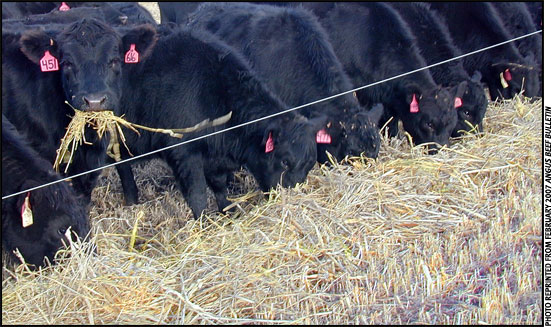
Windrow Grazing
Feeding system offers an efficient way to provide winter feed.
Windrow grazing can save money on feeding costs and enable cows to more efficiently graze into winter. Glenn Shewmaker, extension forage specialist at the University of Idaho, says this gives a more efficient harvest — by the cows — than letting them graze a field that hasn't been cut. They waste more if it's allowed to grow tall and then grazed, he says.
"Even if you didn't ration the windrows by moving electric fence across the field, there would still be significant savings due to less trampling and fouling of the forage," he explains.
Strip-grazing windrows is most efficient. A 2- to 3-day allocation of forage is a good compromise of labor to move a fence. "We can improve harvesting efficiency 10% to 30% or more by strip-grazing," he says.
"The best way to use temporary fence if there's snow covering the windrows, is to put the fence crossways, perpendicular to the windrows. If snow is deep or crusted, the cows will know where those windrows are (since they've already been eating on them in the previous strip) and snow will be broken as they move into the next strip."
"Windrow grazing works best in arid climates — where it's cold rather than warm and humid," Shewmaker says. In a region that gets a lot of fall moisture as rain rather than snow, forage may lose more quality.
"Windrow grazing works with alfalfa, but alfalfa loses its leaves with weathering. Any single species will not preserve as well as mixed species. A mixed grass and legume crop will preserve better than just alfalfa by itself. The windrow will stay more erect and open, and not mat down as much." Initial drying/curing will be better, retaining more nutrients.
Regarding windrow size, you want them large and tall enough to reduce surface area exposed to weathering. Once it's dry and has settled into place it usually won't blow around very much. Keep stubble height tall enough to keep the windrow up off the ground. The forage will dry faster, cure better and have less spoilage on the bottom of the windrow from ground moisture.
"Even with alfalfa, leave at least a 3-inch stubble to keep it from being flat on the ground. If the growing season is short, there may not be enough of a late crop to cut for hay, but windrowing could be a way to preserve it for fall grazing," Shewmaker says.











